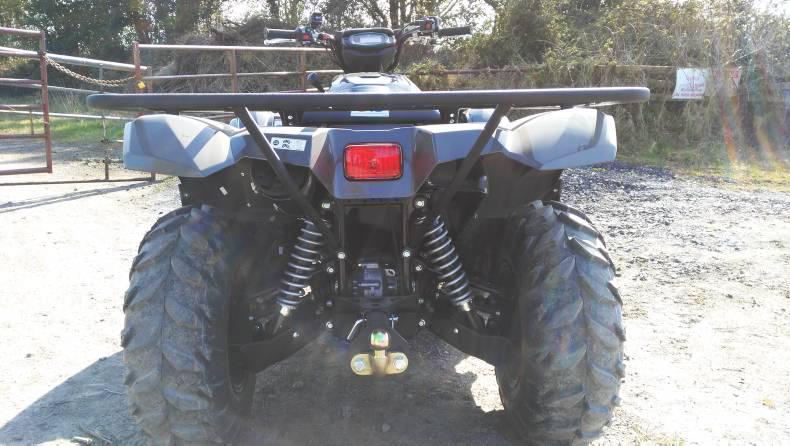The Kodiak has a less aggressive appearance when compared to Yamaha’s Grizzly model, but it’s clear they share the same DNA, with many parts and components shared between the two models. The Kodiak is designed as a smaller, more compact ATV than the Grizzly that is easier to ride and more user-friendly for the farmer.
Engine
The Kodiak is powered by the same fuel-injected 708cc engine found in the Grizzly and is fitted with dual overhead cams and utilises a Mikuni 44mm throttle body to produce plenty of torque on the low end for towing and climbing.
The engine features a 10.1:1 compression ratio and the four-valve head delivers optimum torque for excellent responsiveness, even with heavy loads. As with most fuel-injected ATVs, this machine starts easily and has a very smooth power delivery to suit the working farmer.
Noise sensitive
The engine has a low start-up noise, which is ideal for working around the farmyard or near animals that are sensitive to noise.
The engine is kept cool by a high-capacity radiator fitted with fan assist, which delivers excellent air flow for maximum cooling efficiency and is positioned high in the frame for added protection.
A long, high-mounted engine air intake layout increases power and torque, while also providing additional room for centre storage and easy servicing of the large air filter element located under the seat.
Transmission
The Kodiak 700 features Yamaha’s Ultramatic fully automatic transmission with high, low, reverse and neutral, providing a durable CVT transmission to get the power to the ground. This transmission achieves very natural-feeling engine braking throughout the rpm range.
The transmission is essentially the same as the one found in the Grizzly, although the centrifugal clutch weights are different in order to get the engine rpm to stay low and produce the grunt needed for towing, as well as controlled power output. The difference between the Grizzly clutch setup and the Kodiak is about 12g.

Power does not come on nearly as snappy as it does on the Grizzly, but Yamaha built the Kodiak to be a pure utility ATV, while the Grizzly is more of a combination of sport and utility.
Easy service
A strong and convenient gate-style shifting lever lets the rider easily select the drive setting, while a mechanical rider-engaged 2WD/4WD system with handlebar-mounted setting selection lever puts the rider in control of when to put four-wheel traction to the ground in rough off-road terrain and hard working situations.
The model which we had on test is the top-of-the-range version which is fitted with on-command push-button 4wd and diff lock. A specially designed high-mounted drive system air intake helps reduce the drive system temperatures and also assists in keeping water and debris from entering the drive case.
As with most Yamahas, this Kodiak is super easy to service, with access panels to check the oil and a tool-less foam air filter access, which is under the seat. To keep an eye on engine operation, a digital instrument panel holds all the warning lights, fuel levels, speed, distance and diagnostics.
Chassis
The Kodiak was designed primarily as an easy-to-use ATV suitable for everyone from the adventure seeker to the farmer looking for a durable workhorse; the goal is to make the machine user-friendly.
The chassis is 2in narrower than the Grizzly and the bodywork is also smaller. The new seat is a little slimmer around the middle, which lowers the rider slightly and makes the machine easier to mount and dismount.
The seat is also slim between the legs for a more comfortable rider position. This gives the rider more control and feeling when riding the Kodiak.
Braking is managed by dual hydraulic front disc brakes and a rear-sealed multi-disc brake system. The sealed rear brake system provides ample stopping power during use and is not affected by water, mud or debris.

Our test unit also featured Yamaha’s electronic power steering (EPS). The EPS is input-sensitive and relies on many different factors, such as vehicle speed and driveline function, to determine just how much help it should provide.
Yamaha claims that the amount it assists also adjusts while in 4WD to deliver even more relief while also taking the shock out of harsh impacts when off-roading.
Suspension
The Kodiak features independent double-wishbone suspension front and back, with 7.1in of front wheel travel and 9.1in at the rear. This suspension system provides excellent rider comfort even on the toughest trails, thanks to nitrogen-charged shocks. The SE and EPS models feature five-way adjustable suspension to further enhance the comfort for the rider over various terrain.
The Kodiak offers 10.8in of ground clearance and full-length composite skid plates to deliver maximum underbelly protection for a wide variety of terrain. This is achieved by both the suspension and the exclusively designed 25in Maxxis tyres, which provide precise steering, optimised comfort and maximise available traction when off road or towing.
What it costs to own the Kodiak?
The Kodiak is available in three versions – the standard model, the EPS model (which is fitted with a hitch, power steering, handlebar third light and five-way adjustable suspension) and the model we had on test, the top-of-the-range SE.
The SE has all the features of the standard and EPS models, but is also fitted with on-command push-button 4wd, as opposed to the standard lever-operated version, and is also fitted with a front diff lock. The SE is finished in a carbon paint and is fitted with cast aluminium black wheels as standard. The SE model tested is priced at €11,499 including VAT and comes with a two-year warranty.
To read the full ATVs Focus, click here.
